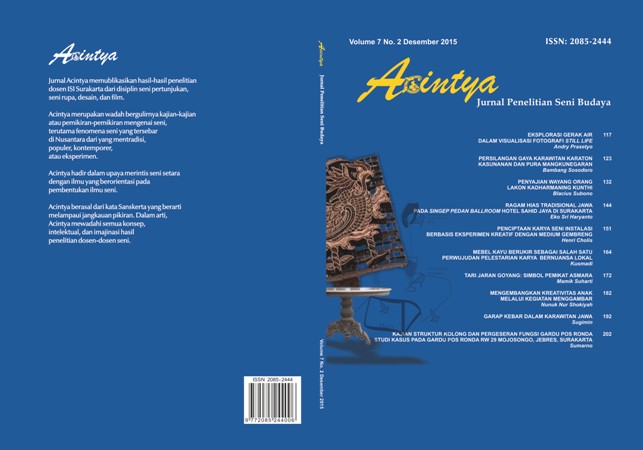KAJIAN STRUKTUR KOLONG DAN PERGESERAN FUNGSI GARDU POS RONDA STUDI KASUS PADA GARDU POS RONDA RW 29 MOJOSONGO, JEBRES, SURAKARTA
DOI:
https://doi.org/10.33153/acy.v7i2.2021Abstract
Night watch guardhouse (gardu pos ronda) is one of Indonesian cultural uniqueness forms compared with other states remaining to exist up to now. In such the condition, guardhouse is also a witness of historical course from several eras accompanying. The uniqueness of guardhouse lies, among otherthings, at its form and the system accompanying it. The structure of guardhouse is as same as other architecture construction consisting of floor, wall and roof. Several guardhouses, by its floor structure, consist of kolong (space underneath main construction) floor and guardhouse exactly on the land. Amid the architectural culture abandoning kolong structure particularly in Java, the structure of guardhouse kolong is an interesting topic to study. It is because the kolong structure is the reflection of Javanese floor construction structure in the past. The objective of research is to find out: (a) what the structure of guardhouse construction is as the interior element; (b) in the present context, how the change of the development of guardhouse function is and what activities it serves in addition to guard security. In order to achieve the objective, the research method employed was a qualitative research.
The research was taken place in Surakarta city. The sampling technique used was purposive sampling one taking all of guardhouses with kolong structure existing in RW 19, Kelurahan Mojosongo, Jebres Subdistrict, Surakarta City. Techniques of collecting data used include interview, recording, library
study, measurement, and documentation. The data validation is conducted using data triangulation, while the data analysis is done by using Miles and Huberman’s interactive model of analysis.
Keywords: guardhouse, kolong structure, function.
Downloads
References
Abidin Kusno, 2007, Penjaga Memori: Gardu di
Perkotaan Jawa, (Yogyakarta: Ombak).
Achmad Maulana, 2008, Kamus Ilmiah Populer.
(Yogyakarta: Absolud).
Bagoes P. Wiryomartono, 1995, Seni Banguan dan
Seni Binakota di Indonesia, Kajian
Mengenai Konsep, Struktur, dan Elemen
Fisik Kota Sejak Peradaban HinduBudha, Islam Hingga Sekarang,
(Jakarta: Gramedia Pustaka Utama).
Denis Lombard, 2008, Nusa Jawa Silang Budaya:
Jaringan Asia, Cet- 4, (Jakarta: Gramedia
Pustaka Utama).
Djoko Soekiman, 2000, Kebudayaan Indis
dan Gaya Hidup Masyarakat
Pendukungnya di Jawa (Abad XVIII –
Medio Abad XX), (Yogyakarta: Bentang
Budaya).
E. Burke Feldman, 1967, Art as Image and Idea
(Englewood Cliffs, New Jersey: Prentice
Hall Inc.).
Eddy S. Marizar, 2005, Designing Furniture, Cet-1
(Yogyakarta: Media Pressindo).
F. Sumiyati, Makna Lambang dan Simbul Kentongan
dalam Masyarakat Indonesia,
(Yogyakarta).
Heddy-Shri Ahimsa-Putra, World Culture Forum (WCF), dalam Spesial Dialog dengan
Meyriska Sari, (Jakarta: ANTV, 2012), 28
November.
Heinz Frick, 2003, Arsitektur dan Lingkungan
(Yogyakarta: Kanisius, Cet-12).
__________, 2001, Pola Struktural dan Teknik
Bangunan di Indonesia, Cet-5
(Yogyakarta: Kanisius).
h t t p : / / i d . w i k i p e d i a . o r g / w i k i /
Mojosongo,_Jebres,_Surakarta
Laurens, Joyce Marcella, 2004, Arsitektur dan
Perilaku Manusia, Cet-1. (Jakarta:
Grasindo).
Matthew B. Miles & A., 1992, Michael Huberman,
Analisis Data Kualitatif, Terj. Tjetjecep
Rohendi Rohidi, Cet-1 (Jakarta: UI
Press).
Martino Dwi Nugroho, Seni Kriya dan Kearifan
Lokal dalam Lintasan Ruang dan
Waktu, (Yogyakarta; BID ISI Yogyakarta,
.
R. Ismunandar, Joglo Rumah Tradisional Jawa, cet-
, (Semarang; Dahara Prize, 2007).
S.A. Mangunsuwito, Kamus Bahasa Jawa,
(Bandung: Yrama Widya, 2002).
Sidharta, 1998, Struktur dalam Arsitektur. Dalam
Arsitektur dan Pendidikanya: Kumpulan
Karangan Sidharta, (Semarang: Jurusan
Arsitektu Fakultas Teknik Universitas
Diponegoro).
Suptandi Setiadi, Sejarah Arsitektur Sebuah
Pengantar, (Jakarta: Gramedia Pustaka
Utama, 2013).
Surono, Jimpitan: Kearifan Masyarakat Jawa dalam
Menjaga Keharmonisan dan
Kesejahteraan Sosial. Laporan Penelitian
Mandiri (Yogyakarta: Pusat Studi
Pancasila UGM, 2011), 1.
Tikno Insufiie, Bisnis Furnitur dan Handicraft
Berkualitas Ekspor, Penekanan pada
Pengetahuan Dasar Cat dan Teknik
Pengecatan (Jakarta: Esensi, 2011).
Tiwuk Sri Rejeki, Laporan Monografi Dinamis Bulan
April, (Surakarta: Kelurahan Mojosongo,
.
Victor Papanek, 1995, The Green Imperative:
Ecology and Ethic in Design and
Architecture (London: Thames and
Hudson).
Yulvianus Harjono, Emansipasi Warga Madani dan
Sejahtera dengan Tradisi Jimpitan, Harian
KOMPAS 10 Juli 2013.
Downloads
Published
How to Cite
Issue
Section
License
Copyright (c) 2017 S., Sumarno

This work is licensed under a Creative Commons Attribution 4.0 International License.
Author continues to retain the copyright if the article is published in this journal. The publisher will only need publishing rights




